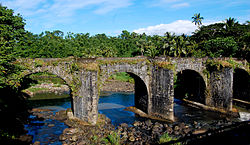Photo Rank Name Span Length Type CarriesCrosses Opened Location Region Ref. 1 Cebu–Cordova Link Expressway 390 m (1,280 ft) 8,900 m (29,200 ft) Cable-stayed 2022 Cebu City –Cordova 10°17′12.7″N 123°53′56.2″E / 10.286861°N 123.898944°E / 10.286861; 123.898944 (Cebu–Cordova Bridge ) Central Visayas [ S 1] [ 5] [ 6] 2 Macapagal Bridge 360 m (1,180 ft) 882 m (2,894 ft) Cable-stayed 2007 Butuan 8°55′21.8″N 125°33′13.6″E / 8.922722°N 125.553778°E / 8.922722; 125.553778 (Macapagal Bridge ) Caraga [ 7] [ 8] [ 9] 3 Magapit Suspension Bridge 256 m (840 ft) 410 m (1,350 ft) Suspension 1978 Lal-lo 18°07′19.9″N 121°40′21.0″E / 18.122194°N 121.672500°E / 18.122194; 121.672500 (Magapit Suspension Bridge ) Cagayan Valley [ S 2] [ 10] [ 11] 4 San Juanico Bridge 192 m (630 ft) 2,164 m (7,100 ft) Truss 1973 Tacloban –Santa Rita 11°18′03.4″N 124°58′12.6″E / 11.300944°N 124.970167°E / 11.300944; 124.970167 (San Juanico Bridge ) Eastern Visayas [ 12] [ 13] 5 Marcelo Fernan Bridge 185 m (607 ft) 1,237 m (4,058 ft) Extradosed 1999 Mandaue –Lapu-Lapu City 10°19′35.5″N 123°57′59.4″E / 10.326528°N 123.966500°E / 10.326528; 123.966500 (Marcelo Fernan Bridge ) Central Visayas [ S 3] [ 14] [ 15] [ 16] 6 Bamban Bridge 174 m (571 ft) 177 m (581 ft) Arch 1998 Bamban –Mabalacat 15°15′37.3″N 120°33′35″E / 15.260361°N 120.55972°E / 15.260361; 120.55972 (Bamban Bridge ) Central Luzon [ S 4] [ 17] [ 18] 7 Agas-Agas Bridge 150 m (490 ft) 350 m (1,150 ft) Box girder 2009 Sogod 10°29′48.2″N 124°59′52.6″E / 10.496722°N 124.997944°E / 10.496722; 124.997944 (Agas-Agas Bridge ) Eastern Visayas [ S 5] [ 19] [ 20] 8 Panguil Bay Bridge 150 m (490 ft) 2,360 m (7,740 ft) Extradosed 2024 Tangub –Tubod 8°03′20.6″N 123°46′39.7″E / 8.055722°N 123.777694°E / 8.055722; 123.777694 (Panguil Bay Bridge ) Northern Mindanao [ 21] [ 22] [ 23] 9 Mactan–Mandaue Bridge 144 m (472 ft) 864 m (2,835 ft) Truss 1973 Mandaue –Lapu-Lapu City 10°19′11.4″N 123°57′21.0″E / 10.319833°N 123.955833°E / 10.319833; 123.955833 (Mactan–Mandaue Bridge ) Central Visayas [ S 6] [ 24] 10 Guadalupe Bridge (MRT) 135 m (443 ft) Arch 1998 Manila 14°34′06.4″N 121°02′45.9″E / 14.568444°N 121.046083°E / 14.568444; 121.046083 (Guadalupe Bridge (MRT) ) Metro Manila [ 25] [ 26] 11 Mawo Bridge 130 m (430 ft)(x2) 259 m (850 ft) Arch 1976 Victoria 12°26′44.6″N 124°18′57.5″E / 12.445722°N 124.315972°E / 12.445722; 124.315972 (Mawo Bridge ) Eastern Visayas [ 27] [ 28] 12 Biliran Bridge 128 m (420 ft) 252 m (827 ft) Arch 1976 Biliran –Leyte 11°27′22.2″N 124°28′46.6″E / 11.456167°N 124.479611°E / 11.456167; 124.479611 (Biliran Bridge ) Eastern Visayas [ 29] [ 30] 13 Santa Monica–Lawton Bridge 105 m (344 ft) 687 m (2,254 ft) Box girder 2021 Manila 14°33′56.7″N 121°03′17.3″E / 14.565750°N 121.054806°E / 14.565750; 121.054806 (Santa Monica–Lawton Bridge ) Metro Manila [ 31] [ 32] 14 Clarin Bridge 104 m (341 ft) 104 m (341 ft) Arch 2022 Loay 9°36′08.7″N 124°00′33.3″E / 9.602417°N 124.009250°E / 9.602417; 124.009250 (Clarin Bridge ) Central Visayas [ 33] 15 Quezon Bridge 102 m (335 ft) 256 m (840 ft) Arch 1939 Manila 14°35′44.0″N 120°58′55.7″E / 14.595556°N 120.982139°E / 14.595556; 120.982139 (Quezon Bridge ) Metro Manila [ 34] [ 35] 16 Liloan Bridge 298 m (978 ft) Arch 1979 Liloan 10°09′45.9″N 125°07′42.5″E / 10.162750°N 125.128472°E / 10.162750; 125.128472 (Liloan Bridge ) Eastern Visayas [ 36] 17 Magsaysay Bridge 856 m (2,808 ft) Truss 1960 Butuan 8°56′52.9″N 125°32′47.2″E / 8.948028°N 125.546444°E / 8.948028; 125.546444 (Magsaysay Bridge ) Caraga 18 LRT Line 1 Viaduct 19,600 m (64,300 ft) Beam bridge Box girder 1984 Manila 14°35′48.4″N 120°58′51.0″E / 14.596778°N 120.980833°E / 14.596778; 120.980833 (LRT Line 1 Viaduct ) Metro Manila [ Note 1] [ 37] [ 38] [ 39] 19 Candaba Viaduct 5,000 m (16,000 ft) Beam bridge 1977 Apalit –Pulilan 14°57′15.7″N 120°46′35.9″E / 14.954361°N 120.776639°E / 14.954361; 120.776639 (Candaba Viaduct ) Central Luzon [ S 7] [ 40] 




















































